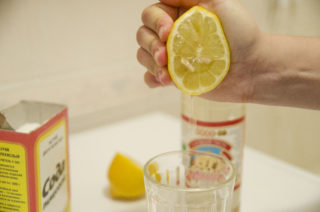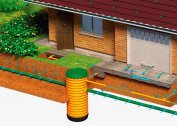When a plaque forms in the sewers, it happens that for various reasons there is no way to resort to the help of plumbers. If this situation occurs, you can try to clean the blockage yourself. To do this, you will need soda and vinegar.
What is a blockage and why is it dangerous
 When operating sewer pipes over time, deposits accumulate on them in the form of grease, detergents and food debris. This can make it difficult to drain water into the sewer. The mud layer can be so thick that it completely blocks the drain. The problem is equally relevant for both metal and plastic pipes. The pipe connected to the kitchen sink is most susceptible to blockages, the second place in the risk group is occupied by the pipe on the bathtub drain. Clogging in the toilet pipes can occur only due to operational disturbances, when rags, plastic bags and hygiene products get into the pipe.
When operating sewer pipes over time, deposits accumulate on them in the form of grease, detergents and food debris. This can make it difficult to drain water into the sewer. The mud layer can be so thick that it completely blocks the drain. The problem is equally relevant for both metal and plastic pipes. The pipe connected to the kitchen sink is most susceptible to blockages, the second place in the risk group is occupied by the pipe on the bathtub drain. Clogging in the toilet pipes can occur only due to operational disturbances, when rags, plastic bags and hygiene products get into the pipe.
In addition to the regular ingress of fat and organic substances into the pipes, the cause of blockages can be the incorrect location of the water supply, in particular a small slope or overflow of the cesspool, if it is a private house.
The use of soda and vinegar is effective when the first signs of clogging appear, if the water has completely stopped going into the sewer, you will have to use a mechanical cleaning method using a special cable.
What you need to cook for cleaning
 Before starting the cleaning procedure, it is necessary to shut off the water in the system, remove the siphons, disassemble and clean them. First, you need to put some capacity under the sumps to drain dirty water and sediment. After the siphons are cleaned and collected, you can proceed to cleaning the sewer pipes. To do this, prepare:
Before starting the cleaning procedure, it is necessary to shut off the water in the system, remove the siphons, disassemble and clean them. First, you need to put some capacity under the sumps to drain dirty water and sediment. After the siphons are cleaned and collected, you can proceed to cleaning the sewer pipes. To do this, prepare:
- Baking soda. Approximately 250 grams per drain.
- Vinegar. About 100 ml per drain hole.
- Three liters of boiling water.
- Thick fabric to tightly plug the drain hole.
- Latex gloves.
- Mask for respiratory protection.
- You can also use goggles, as a pair of vinegar can aggressively act on the mucous membrane.
Several cleaning methods using soda and vinegar
 Method 1
Method 1
- Pour prepared soda into the drain hole. It is very important that at this moment it remains dry.
- Gently pour 100-150 ml of vinegar in soda. It is better if it is a little heated. It is necessary to strictly adhere to the dose, a larger amount of vinegar is not recommended.
- Quickly plug the drain hole with a rag so that the reaction that starts spreads inside the pipe.
- Leave the pipe in this condition for half an hour. During this time, as a result of a chemical reaction, precipitation clogging the pipe should dissolve.
- While cleaning, you need to prepare boiling water.
- After the set time, the rag should be removed and gradually pour all the prepared boiling water into the drain hole.
If after all the manipulations done, the water still doesn’t drain well enough, the procedure must be repeated. This can be done already without the use of vinegar, using only soda solution.
This is done according to the following scheme:
- Half a pack of salt is poured into the drain hole, so that the powder is fully placed in the drain pipe.
- Next, pour 600-700 ml of boiling water.
This method is effective as a second cleaning agent after a more intense exposure, as an independent manipulation for weak clogging, and also as a preventive measure
Method 2
 For this method, in addition to all of the above, citric acid will be needed.
For this method, in addition to all of the above, citric acid will be needed.
- Mix vinegar and citric acid. The mixture does not need to be heated.You can use the juice of half a lemon.
- Similarly to the first method, pour soda into the drain and then gently pour the vinegar-lemon mixture.
- Plug the drain hole with a rag and hold the composition in the pipe for two hours.
- After the set time, turn on the most hot water and flush the sewer for about ten minutes.
Method 3
 If the blockage is strong enough, the above methods may not be effective enough. To achieve the desired result, you can increase the acidity of the composition used. To do this, use soda ash. You can make it at home.
If the blockage is strong enough, the above methods may not be effective enough. To achieve the desired result, you can increase the acidity of the composition used. To do this, use soda ash. You can make it at home.
- Pour 150 grams of baking soda into the pan and heat.
- When heated above 60 degrees, a reaction will begin, due to which water and carbon dioxide will evaporate and only soda ash will remain in the pan.
- The resulting powder must be cooled and poured into the sewer.
- Then pour 80 ml of vinegar and wait two hours.
- After the set time, rinse the sewer with warm water.
An alternative to vinegar in the above methods is salt. This option is suitable for those who are intolerant of vinegar fumes or if vinegar is simply not at hand.
It takes half a pack of soda and the same amount of salt. The ingredients must be mixed and poured into the drain hole. On top of the dry ingredients gradually pour about a liter of boiling water. In the next eight hours, it will not be possible to use the sewage system, during this time all the reactions necessary for cleaning should go through, therefore it is best to perform this procedure at night. After the allotted time, you need to open the tap with cold water and make sure that the drain cleaning is successful.
You can also use a plunger to speed up the process. It quickly and efficiently removes cork residues.
You should not use immediately after one another folk methods of cleaning the sewer and purchased chemicals. This can lead to the formation of toxic fumes.
Any problem is always better to prevent than to deal with its consequences. In order to prevent severe blockage, it is necessary to respond in a timely manner to the fact that the water has become worse to go into the drain. It was at this time that it was effective to clean the sewer using soda and vinegar. Timely organized manipulation will help not only to cope with the first signs of blockage, but also serve as an excellent prevention.


